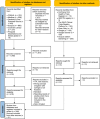Oral Irrigation Devices: A Scoping Review
- PMID: 38881230
- PMCID: PMC11180943
- DOI: 10.1002/cre2.912
Oral Irrigation Devices: A Scoping Review
Abstract
Objectives: Self-performed oral hygiene is essential for preventing dental caries, periodontal, and peri-implant diseases. Oral irrigators are adjunctive oral home care aids that may benefit oral health. However, the effects of oral irrigation on oral health, its role in oral home care, and its mechanism of action are not fully understood. A comprehensive search of the literature revealed no existing broad scoping reviews on oral irrigators. Therefore, this study aimed to provide a comprehensive systematic review of the literature on oral irrigation devices and identify evidence gaps.
Methods: The Joanna Briggs Institute and Preferred Reporting Items for Systematic reviews and Meta-Analyses extension for Scoping Reviews guidelines were utilized to prepare the review. Four databases and eight gray literature sources were searched for English publications across any geographical location or setting.
Results: Two hundred and seventy-five sources were included, predominantly from scientific journals and academic settings. Most studies originated from North America. Research primarily involved adults, with limited studies in children and adolescents. Oral irrigation was safe and well-accepted when used appropriately. It reduced periodontal inflammation, potentially by modulating the oral microbiota, but further research needs to clarify its mechanism of action. Promising results were reported in populations with dental implants and special needs. Patient acceptance appeared high, but standardized patient-reported outcome measures were rarely used. Anti-inflammatory benefits occurred consistently across populations and irrigant solutions. Plaque reduction findings were mixed, potentially reflecting differences in study designs and devices.
Conclusions: Oral irrigators reduce periodontal inflammation, but their impact on plaque removal remains unclear. Well-designed, sufficiently powered trials of appropriate duration need to assess the clinical, microbiological, and inflammatory responses of the periodontium to oral irrigation, particularly those with periodontitis, dental implants, and special needs. Patient-reported outcome measures, costs, caries prevention, and environmental impact of oral irrigation need to be compared to other oral hygiene aids.
Keywords: dental devices, home care; dental plaque; oral hygiene; periodontitis.
© 2024 The Author(s). Clinical and Experimental Dental Research published by John Wiley & Sons Ltd.
Conflict of interest statement
The authors declare no conflicts of interest.
Figures





References
-
- Abdul Aziz, A. H. , Afifah N. A., and Syahmi N. M.. 2018. “New Water Irrigator for Cleaning Dental Plaque.” International Journal for Innovation Education and Research 6, no. 10: 299–305. 10.31686/ijier.Vol6.Iss10.1190. - DOI
-
- Aijima, R. , and Yamashita Y.. 2023. “Effectiveness of Perioperative Oral Hygiene Management Using a Cetylpyridinium Chloride‐, Dipotassium Glycyrrhizinate, and Tranexamic Acid‐Based Mouthwash as an Adjunct to Mechanical Oral Hygiene in Patients With Maxillomandibular Fixation: A Randomized Controlled Clinical Trial.” Clinical and Experimental Dental Research 9, no. 6: 1044–1050. 10.1002/cre2.814. - DOI - PMC - PubMed
Publication types
MeSH terms
Grants and funding
LinkOut - more resources
Full Text Sources
Medical

